SHARE WITH FRIENDS:
Khiva - Ichan Qala
Ichan Qala is the largest and unique architectural monument in Central Asia. The inner fortress (Shahristan) part of Khiva city, Ichan Qala is separated from the Dishan fortress (outer fortress) part of the city by a kungurador wall. It looks like a high fortress from Khiva raboti (Dishan fortress). Ichan Castle is entered through 4 gates (Garden Gate, Polvon Gate, Stone Gate, Father Gate).
The magnificent monuments of Khorezmian folk architecture: madrasas, mosques, palaces and minarets, mainly in Ichan Qala. The history of the creation of architectural monuments in it mainly belongs to 4 periods: the first is the ancient Khorezm. From the time of the Mongol conquest to the present day, the western wall of the Kokna arch, the ancient tower in the north-eastern corner of the Qala wall, and the remains of the Qala wall have been preserved. The second is the period of recovery of Khorezm after the Mongol invasion in 1220. During this period, the mausoleum of Sayyid Alovuddin and other monumental buildings were built. The third period dates back to the XVI-XVII centuries. At the same time (during the reign of Abulgazikhan and Asfandiyarkhan) Anushakhan bath (1657), White Mosque (1675), Khojamberdibek madrasa (1688) were built in Ichan Qala, fortifications of the Old Ark were strengthened, khan's reception) was built (1686-88). As a result of the war between Bukhara and Iran for the Khiva khanate (1st half of the XNUMXth century), Ichan Qala and the city of Khiva in general were severely damaged (Khiva was a province of Iran for some time).
The fourth period covers the XVIII-XX centuries. During this period, mosques, madrasas, tims and taqis were built based on the traditions of Central Asian local architecture. There was a big passage from the main gate to the Polvon gate. At the end of the 1840th century, the Juma Mosque was rebuilt and a tall minaret was erected next to it. The ruined walls of Ichan Castle were restored, and several buildings were repaired. In 12-1806, tim and taqi were built on the two-story Kutlug Murad Inoq madrasah. During the reigns of Muhammad Rahimkhan (25-1825), Allakulikhan (42-1845), Muhammad Aminkhan (55-XNUMX) construction in Ichan Qala flourished. A magnificent palace, a madrasa, and mausoleums were built: the construction of the old arksat palace was completed. A new and large Stone Courtyard Palace was built. A part of the fortress wall near the Polvon gate was demolished and replaced by the Allakulikhon caravanserai, madrasa and timid, and the mausoleum of Pahlavon Mahmud, a great example of folk art, was erected. Arab Muhammadkhan and Musa Tura madrasas were also established during this period. Muhammad Aminkhan built a minaret on the west side of the Ichan Fortress, near the Old Arch, known as the Kalpsh Minor. Although this tower is unfinished, it plays a major role in the Ichan Qala monument.
In the construction of the Ichan Qala, Khiva architects used a method that has long been used in Central Asia - the method of face-to-face construction ("double"). Mac, Allakulikhon madrassah and Kutlug Murad Inoq madrassah, Shergozikhan madrassah and Pahlavon Mahmud mausoleum were built in this style. Another distinctive feature of Ichan Qala architecture is that the buildings are built as a separate ensemble. The two small madrasas near the Juma mosque, the Muhammad Amin Inoq and Matpanoboy madrasas, and the Matniyaz devonbegi madrassah are much larger ensembles. Several mosques and madrasas in front of the Polvon Gate, ham-mom, taqi, caravanserai and khan's palace form a unique ensemble. The square between Kutlug Murad Inoq and Allakulikhan madrassah, the Stone Yard and the White Mosque is the center of the ensemble.
The architectural monuments of Ichan Qala are decorated with wood carvings, stone carvings, pottery, vinegar pottery and other colorful ornaments. The Ichan Qala ensemble was preserved as an architectural monument and turned into a museum (1961). Since 1990, Ichan Qala has been included in the World Heritage List.
In 1997, on the occasion of the 2500th anniversary of the city of Khiva, the monuments located on the main routes were regularly repaired.
tourist.com
